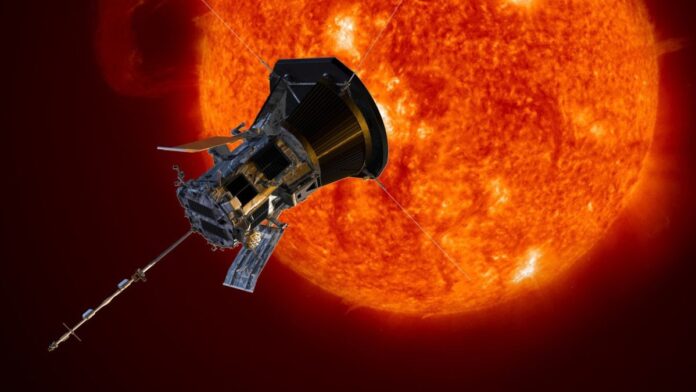NASA’s most advanced spacecraft for solar exploration just made another close flyby of the sun.
The Parker Solar Probe conducted its 16th perihelion pass on Thursday morning (June 22), cruising through the sun’s superhot outer atmosphere, called the corona.
As the spacecraft flies through the corona’s blazing plasma, where temperatures can climb above 1.8 million degrees Fahrenheit (1 million degrees Celsius), the instruments onboard the probe are kept at a comfortable 85 degrees F (29.4 degrees C). This is due to the probe’s heat shield, which is 4.5 inches (11.4 centimeters) thick and can safely reach temperatures hotter than 2,500 degrees F (1,400 degrees C).
Related: Parker Solar Probe: First spacecraft to ‘touch’ the sun
The Parker Solar Probe launched in August 2018 and was placed into a highly elliptical orbit around the sun. During its perihelion passes through the corona, the spacecraft can dip below 6 million miles (9.6 million kilometers) above the sun’s surface, which is known as the photosphere.
The spacecraft is scheduled to make 24 close passes of the photosphere during its primary mission, collecting data scientists will use to improve stellar models and the ability to forecast space weather events that can pose a danger to satellites and power grids.
The photosphere has an average temperature around 10,000 degrees F (5,800 degrees C), making it hundreds of times cooler than the coronal layer above, and this is something that makes scientists scratch their heads. Simulations of the sun’s internal nuclear fusion reactions suggest that regions of the sun should increase in temperature and pressure the closer they are to the core of the star.
The sun’s corona is difficult to study from the surface of Earth; it’s outshined by the photosphere, which is the big, bright yellow ball you see in the sky when you look at the sun. (But don’t look at the sun!) However, the corona is visible from Earth during total solar eclipses, which is part of the reason that solar scientists are so excited about these cosmic events.
By studying the disparities in temperature between different layers of the sun’s atmosphere, researchers hope to gain a better understanding of the process causing the star’s coronal heating, and how that affects the acceleration of the solar wind, the stream of charged particles flowing continuously from the sun.
In addition to the Parker Solar Probe’s 24 planned dips through the sun’s corona, seven flybys of the planet Venus were also built into the spacecraft’s mission. These are designed to slow the probe’s velocity and calibrate its trajectory, according to NASA’s website. There are two such passes left for the spacecraft, with the next projected for Aug. 21. The Parker Solar Probe reached its 15th perihelion on March 17 of this year and will return for its 17th on Sept. 27.

